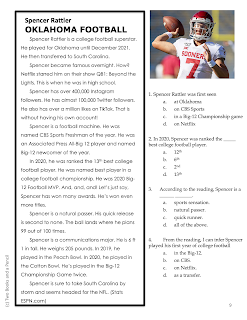Winter Solstice Around the World Unit Reading Comprehension and Fluency
This a student-centered, print-n-go, turn-key fluency, reading comprehension and standards-
based Winter Solstice Around the World Unit. Please look at the preview - it is the entire print version of the resource. Included are print, Google Slide and Easel versions.
Table of Contents
Fluency Research page 3
Evidence-Based Program and Lexile Measures page 4
Lexile Grade Level Reading Chart page 5
Fluency Instructions and Optional Instructional Script page 6
Fluency Passage 1: Zuni Winter Solstice 810L-1100L page 8
Comprehension Check
Close Read
Fluency Passage 2: Zuni Winter Solstice in Depth 810L-1100L page 10
Comprehension Check
Close Read
Text-to Text Zuni Shalako Compare Two Texts page 13
Shab-E Yalda, Iran 810L-11100L page 14
Shab-E Yalda, Iran Construct a Brochure page 15
Monsters of the Winter Solstice 810L-1100L page 16
Fluency Passage 3: Saturnalia 810L-1010L page 17
Comprehension Check page 18
Saturnalia Left Hanging page 19
Answers page 20
December Intervention Bundle - A Christmas Carol & December Holidays
December Intervention Bundle includes reading comprehension and fluency for both informational text and fiction. Engaging high interest low level work for older struggling readers. Includes "A Christmas Carol," Christmas, Hanukkah, Kwanzaa, Yule, Christmas Around the World, and more.
Resource 1 : High Low Reading Comprehension for Older Students December Christmas Hanukkah +
SET 9: 20 High interest, low level reading comprehension passage for grades 5-12 that are December Holiday-themed. These reading comprehension passages are perfect for older struggling readers and include Hanukkah, Christmas, Kwanzaa, and more.
These December Holiday-Themed passages are diverse and inclusive to deal with the December Dilemma.
Passages are at reading levels grade 1-3 - without sounding OR LOOKING like it.
20 High Interest, Low Level reading passage for grades 5-12. These passages are perfect for older struggling readers and are aligned with the middle school and high school English Language Arts CCSS.
This resource contains:
- A printable PDF for packets or classroom work – with lines for students to complete their work
- Answer document
- Easel version
For Google Drive Version Click Here.
These are 20 HIGH INTEREST-LOW LEVEL READABILITY PASSAGES – perfect for Distance, Digital, Hybrid and Classroom learning. They are designed for students to read on their own and complete quick assessments. The assessments contain four to five multiple-choice questions and one or two short constructed-response questions or are otherwise standards-based.
20 reading passages, with comprehension assessments, that are high interest but at accessible reading levels. This resource is perfect for reluctant older readers who need reading practice but are put off by text that looks “young” or “babyish.”
The reading techniques used in this resource are research-based and appeal to students in grades 5 through 12. Readability scores were determined using the Renaissance ATOS calculator.
Passages:
Zuni Winter Solstice page 8
Dong Zhi page 9
Hopi Soyal page 10
Hanukkah page 11
Hanukkah Fun - The Dreidel – Fact and Opinion page 12
Ramadan page 13
A Day During Ramadan – Fact or Opinion page 14
When is Ramadan page 15
Kwanzaa page 16
Christmas page 17
Christmas Tree Facts page 18
Christmas Around the World page 19
Yule page 20
Bodhi Day page 21
Boxing Day page 22
Krampusnacht page 23
Fact and Opinion – Human Rights Day page 24
Three Kings Day page 25
December at School page 26
History of Christmas Carols page 27
The Hanukkah Song page 28
Answers page 29
Thank you for looking!
+++++++++++++++++++++++++++++++++++++++++++++++++++++++++++++++++++++++
Resource 2: A Christmas Carol A NOVEL in High Low Reading Comprehension Fluency Passages
Here is the entire novel A Christmas Carol by Charles Dickens divided into high interest - low level reading passages. Passage reading levels range from 2 to 3.6 . Standards-Aligned assignments, fluency checks, and comprehension work for each of the 20 passages. Plus, literary devices and higher order thinking questions designed specifically for older students struggling or reluctant readers.
This is an engaging story that older, lower-level readers my never experience – but should. A Christmas Carol has all of the elements that engage teens who now are able access the story,
themes and brilliance of Dicken's classic - at a lower reading level. Each passage has a comprehension assessment, fluency check and Cloze Read. The passages are meant to be read in order.Perfect for homework, classwork, standards-based ELA instruction and distance learning-- this resource contains multiple versions – 68-page pdf, Easel and Google - for all learning situations.
High Interest – Low Readability passages are perfect for both in class and distance learning Why? Because students are able to read the passages on their own and complete quick comprehension assessments, access literary devices, and practice fluency.
This resource is perfect for reluctant older readers who need reading practice but are put off by text that looks “young” or “babyish.” The passages are A Christmas Carol for them.
Written using research-based techniques – the passages repeat words, scaffold and introduce vocabulary. Research is included.
Readability scores are determined in Lexile Levels.















